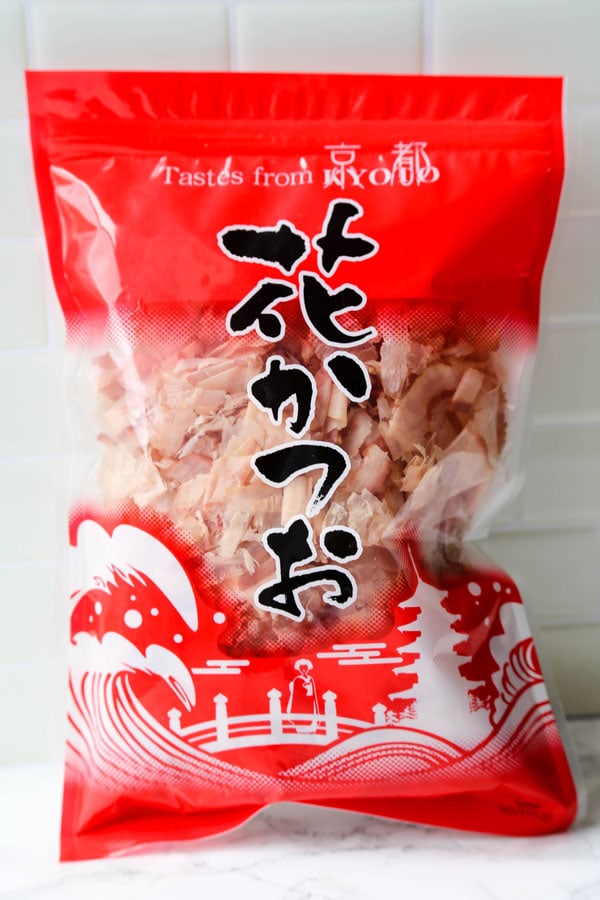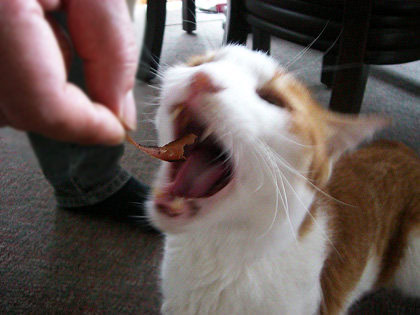
These are the umami loaded fish flakes that dance on top of your Okonomiyaki, fresh off the grill-top at the Izakaya. Bonito flakes are called katsuobushi – 鰹節 – in Japanese.
What are bonito flakes made from?
Made of smoked bonito or skipjack tuna that has been fermented and dried into blocks as hard as wood – the fish is then shaved in to mega-thin ribbons and packaged up.
What do bonito flakes taste like?
There’s a salty and smoky element to katsuobushi that can vary in intensity from brand to brand.
Do these flakes taste fishy? Yes. But not overly so. It might be easiest to think of katsuobushi as paper-thin, dry ribbons of high quality fish jerky.
Katsuobushi and dried kelp are the main flavors in dashi (the ubiquitous broth used in soba, sunomono, miso soup and oden, etc).
You will also find the savory fish flakes used as a stuffing in okaka (おかか) onigiri, a topping on takoyaki and a texture/flavor element on cold tofu.
Why are my bonito flakes moving?
If you’ve ever ordered okonomiyaki at an izakaya, you’ve probably seen the dried bonito flakes swaying back and forth on top of your food. This can be pretty dramatic to see for the first time!
However, the reason for this motion is pretty simple: as steam from the hot food rises, it rehydrates the ribbon thin fish flakes, causing them to move to and fro until they are fully saturated.

Recipes Using Bonito Flakes
- How to Make Dashi
- Okonomiyaki
- Homemade Ponzu Sauce
- Japanese Style Grilled Bell Peppers
- Onigiri (Rice Balls)
Dashi
Bonito flakes make wonderful base-broths used in many soups. They impart a flavor that’s umami-rich and authentically Japanese.
At the heart of Japanese cuisine is a stock made of katsuobushi and konbu (kelp).
It is called Dashi (だし) – and it’s the base stock used in simmered dishes, broths and – most famously, some versions of miso soup. Many instant brands of dashi do a pretty good job of replicating the original homemade version – however lose some of the nuance and subtlety of making it yourself easily with just a couple ingredients.
And there are a few variations on the original that call for dried sardines or shiitake mushrooms to round out the umami of the broth. Using thicker Ma-Konbu (meaning ‘real konbu’) harvested in it’s second year is a great way to add serious depth of flavor to your dashi stock.
How to make dashi stock
Making dashi is very easy!
I’ve written a post about how to make it at home using either bonito flakes or kombu. Click here to read my post on How to Make Dashi.

Bonito flakes and cats
OMG… kitties love the taste of katsuobushi!
In fact, it’s best not to let your four-pawed feline friend find your bag of bonito flakes – unless you want them to devour the entire contents in a purring frenzy.
I have a kitty, so I know exactly how crazy cats can get as soon as they catch a whiff of those yummy fish flakes!
Since bonito flakes are very low in calories, they make a great snack for cats, especially those who are on a restricted diet.
I’m sure you’ve noticed how expensive bonito flakes sold at pet stores can be (it’s highway robbery). So what is a pet owner to do when their favorite kitty meows and begs for more fish flakes? Go to Amazon and order a bag of it for a fraction of the price!














